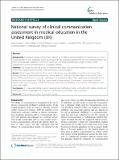Files in this item
National survey of clinical communication assessment in medical education in the United Kingdom (UK)
Item metadata
| dc.contributor.author | Laidlaw, Anita Helen | |
| dc.contributor.author | Salisbury, Helen | |
| dc.contributor.author | Doherty, Eva M | |
| dc.contributor.author | Wiskin, Connie | |
| dc.date.accessioned | 2014-02-11T13:01:02Z | |
| dc.date.available | 2014-02-11T13:01:02Z | |
| dc.date.issued | 2014-01-13 | |
| dc.identifier | 96530959 | |
| dc.identifier | b89215d1-f2ee-4d45-8af5-b2d9214aa234 | |
| dc.identifier | 84892401201 | |
| dc.identifier | 000330059700002 | |
| dc.identifier.citation | Laidlaw , A H , Salisbury , H , Doherty , E M & Wiskin , C 2014 , ' National survey of clinical communication assessment in medical education in the United Kingdom (UK) ' , BMC Medical Education , vol. 14 , 10 . https://doi.org/10.1186/1472-6920-14-10 | en |
| dc.identifier.issn | 1472-6920 | |
| dc.identifier.other | ORCID: /0000-0003-1214-4100/work/59698711 | |
| dc.identifier.uri | https://hdl.handle.net/10023/4436 | |
| dc.description.abstract | Background All medical schools in the UK are required to be able to provide evidence of competence in clinical communication in their graduates. This is usually provided by summative assessment of clinical communication, but there is considerable variation in how this is carried out. This study aimed to gain insight into the current assessment of clinical communication in UK medical schools. Methods The survey was sent via e-mail to communication leads who then were asked to consult with all staff within their medical school involved in the assessment of communication. Results Results were obtained from 27 out of 33 schools (response rate 82%) and a total of 34 courses. The average number of assessments per year was 2.4 (minimum 0, maximum 10). The Objective Structured Clinical Exam (OSCE) was the most commonly used method of assessment (53%). Other assessments included MCQ and workplace based assessments. Only nine courses used a single method of assessment. Issues raised included, logistics and costs of assessing mainly by OSCE, the robustness and reliability of such exams and integration with other clinical skills. Conclusions It is encouraging that a variety of assessment methods are being used within UK medical schools and that these methods target different components of clinical communication skills acquisition. | |
| dc.format.extent | 228772 | |
| dc.language.iso | eng | |
| dc.relation.ispartof | BMC Medical Education | en |
| dc.subject | Clinical communication | en |
| dc.subject | Assessment | en |
| dc.subject | Survey | en |
| dc.subject | R Medicine | en |
| dc.subject.lcc | R | en |
| dc.title | National survey of clinical communication assessment in medical education in the United Kingdom (UK) | en |
| dc.type | Journal article | en |
| dc.contributor.institution | University of St Andrews. School of Medicine | en |
| dc.contributor.institution | University of St Andrews. Health Psychology | en |
| dc.identifier.doi | 10.1186/1472-6920-14-10 | |
| dc.description.status | Peer reviewed | en |
This item appears in the following Collection(s)
Items in the St Andrews Research Repository are protected by copyright, with all rights reserved, unless otherwise indicated.

